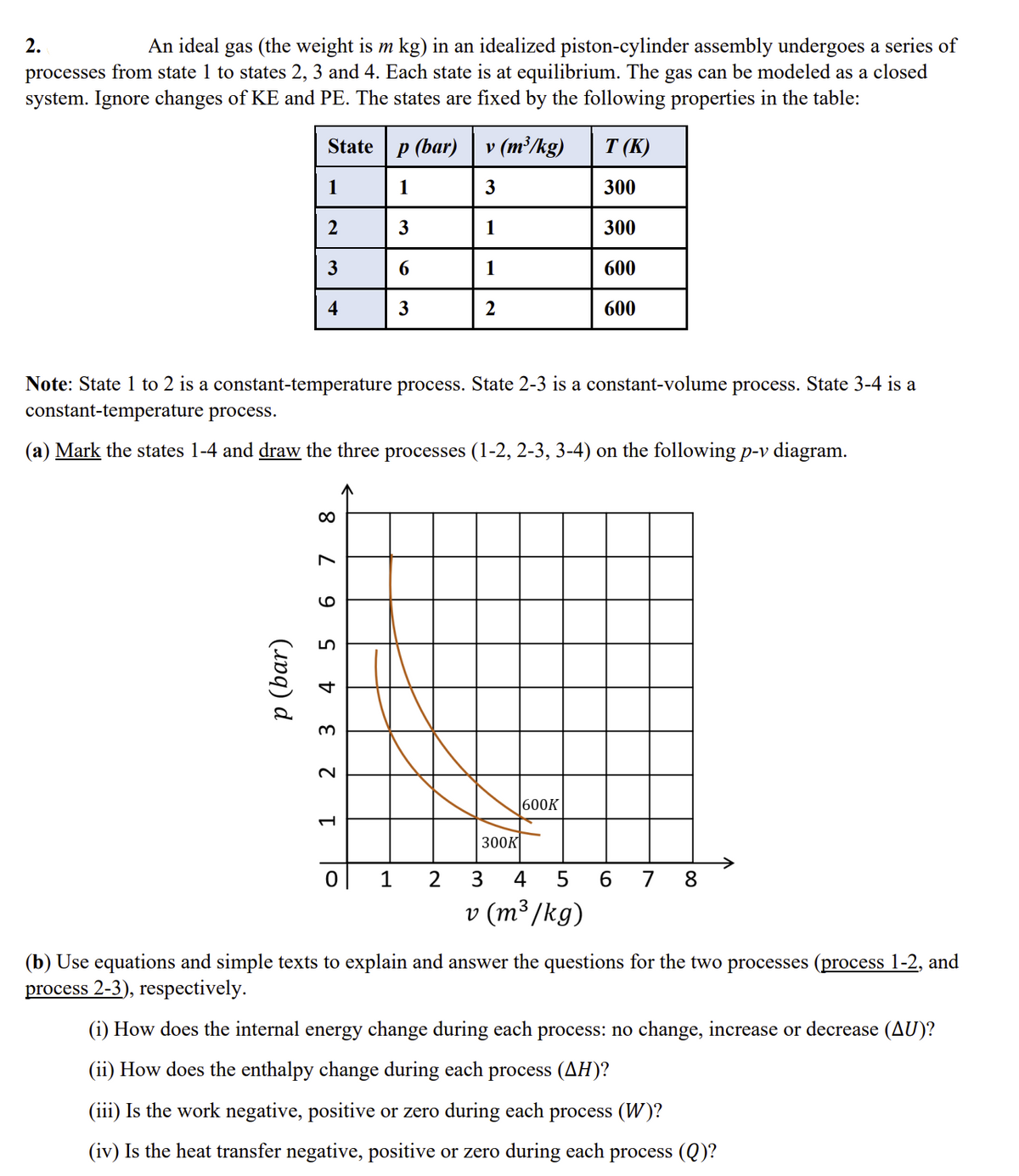2. An ideal gas (the weight is m kg) in an idealized piston-cylinder assembly undergoes a series of processes from state 1 to states 2, 3 and 4. Each state is at equilibrium. The gas can be modeled as a closed system. Ignore changes of KE and PE. The states are fixed by the following properties in the table: State p (bar) 1 2 3 4 8 Note: State 1 to 2 is a constant-temperature process. State 2-3 is a constant-volume process. State 3-4 is a constant-temperature process. (a) Mark the states 1-4 and draw the three processes (1-2, 2-3, 3-4) on the following p-v diagram. 5 tz 3 2 J 0 p (bar) 1 3 6 3 1 v (m³/kg) 3 1 1 2 2 300K 600K T (K) 300 300 600 600 3 4 5 v (m³/kg) 6 7 8 (b) Use equations and simple texts to explain and answer the questions for the two processes (process 1-2, and process 2-3), respectively. (i) How does the internal energy change during each process: no change, increase or decrease (AU)? (ii) How does the enthalpy change during each process (AH)? (iii) Is the work negative, positive or zero during each process (W)? (iv) Is the heat transfer negative, positive or zero during each process (Q)?
2. An ideal gas (the weight is m kg) in an idealized piston-cylinder assembly undergoes a series of processes from state 1 to states 2, 3 and 4. Each state is at equilibrium. The gas can be modeled as a closed system. Ignore changes of KE and PE. The states are fixed by the following properties in the table: State p (bar) 1 2 3 4 8 Note: State 1 to 2 is a constant-temperature process. State 2-3 is a constant-volume process. State 3-4 is a constant-temperature process. (a) Mark the states 1-4 and draw the three processes (1-2, 2-3, 3-4) on the following p-v diagram. 5 tz 3 2 J 0 p (bar) 1 3 6 3 1 v (m³/kg) 3 1 1 2 2 300K 600K T (K) 300 300 600 600 3 4 5 v (m³/kg) 6 7 8 (b) Use equations and simple texts to explain and answer the questions for the two processes (process 1-2, and process 2-3), respectively. (i) How does the internal energy change during each process: no change, increase or decrease (AU)? (ii) How does the enthalpy change during each process (AH)? (iii) Is the work negative, positive or zero during each process (W)? (iv) Is the heat transfer negative, positive or zero during each process (Q)?
Elements Of Electromagnetics
7th Edition
ISBN:9780190698614
Author:Sadiku, Matthew N. O.
Publisher:Sadiku, Matthew N. O.
ChapterMA: Math Assessment
Section: Chapter Questions
Problem 1.1MA
Related questions
Question

Transcribed Image Text:2.
An ideal gas (the weight is m kg) in an idealized piston-cylinder assembly undergoes a series of
processes from state 1 to states 2, 3 and 4. Each state is at equilibrium. The gas can be modeled as a closed
system. Ignore changes of KE and PE. The states are fixed by the following properties in the table:
State
1
2
3
4
8
7
9
Note: State 1 to 2 is a constant-temperature process. State 2-3 is a constant-volume process. State 3-4 is a
constant-temperature process.
(a) Mark the states 1-4 and draw the three processes (1-2, 2-3, 3-4) on the following p-v diagram.
p (bar)
4 5
3
1 2
0
p (bar)
1
3
1
6
3
v (m³/kg)
3
1
1
2
2
300K
600K
T (K)
300
300
600
600
3 4 5
v (m³/kg)
6 7 8
(b) Use equations and simple texts to explain and answer the questions for the two processes (process 1-2, and
process 2-3), respectively.
(i) How does the internal energy change during each process: no change, increase or decrease (AU)?
(ii) How does the enthalpy change during each process (AH)?
(iii) Is the work negative, positive or zero during each process (W)?
(iv) Is the heat transfer negative, positive or zero during each process (Q)?
Expert Solution
This question has been solved!
Explore an expertly crafted, step-by-step solution for a thorough understanding of key concepts.
Step by step
Solved in 2 steps with 2 images

Knowledge Booster
Learn more about
Need a deep-dive on the concept behind this application? Look no further. Learn more about this topic, mechanical-engineering and related others by exploring similar questions and additional content below.Recommended textbooks for you

Elements Of Electromagnetics
Mechanical Engineering
ISBN:
9780190698614
Author:
Sadiku, Matthew N. O.
Publisher:
Oxford University Press

Mechanics of Materials (10th Edition)
Mechanical Engineering
ISBN:
9780134319650
Author:
Russell C. Hibbeler
Publisher:
PEARSON

Thermodynamics: An Engineering Approach
Mechanical Engineering
ISBN:
9781259822674
Author:
Yunus A. Cengel Dr., Michael A. Boles
Publisher:
McGraw-Hill Education

Elements Of Electromagnetics
Mechanical Engineering
ISBN:
9780190698614
Author:
Sadiku, Matthew N. O.
Publisher:
Oxford University Press

Mechanics of Materials (10th Edition)
Mechanical Engineering
ISBN:
9780134319650
Author:
Russell C. Hibbeler
Publisher:
PEARSON

Thermodynamics: An Engineering Approach
Mechanical Engineering
ISBN:
9781259822674
Author:
Yunus A. Cengel Dr., Michael A. Boles
Publisher:
McGraw-Hill Education

Control Systems Engineering
Mechanical Engineering
ISBN:
9781118170519
Author:
Norman S. Nise
Publisher:
WILEY

Mechanics of Materials (MindTap Course List)
Mechanical Engineering
ISBN:
9781337093347
Author:
Barry J. Goodno, James M. Gere
Publisher:
Cengage Learning

Engineering Mechanics: Statics
Mechanical Engineering
ISBN:
9781118807330
Author:
James L. Meriam, L. G. Kraige, J. N. Bolton
Publisher:
WILEY